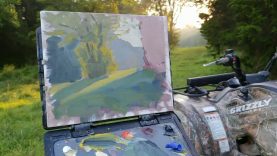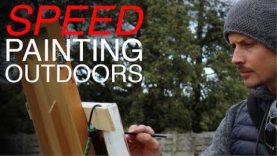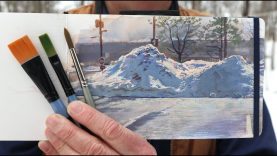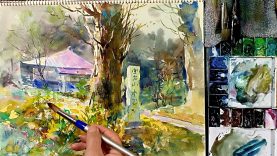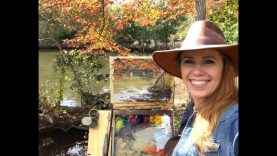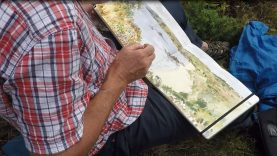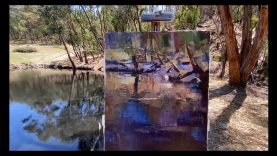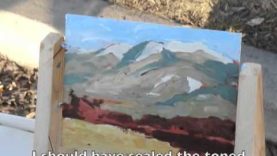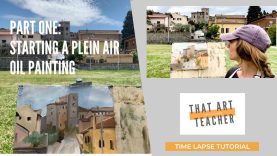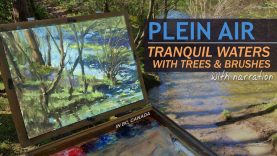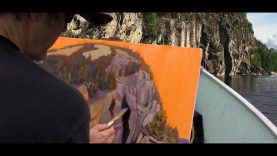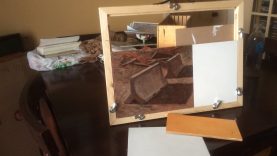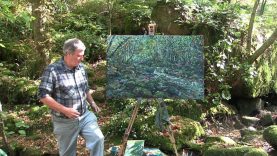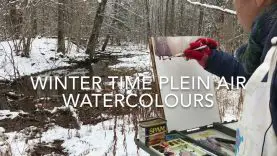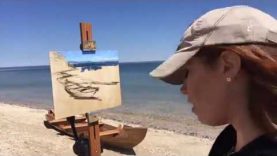Pros & Cons of Plein Air Watercolor Painting
For many years, I refused to consider adding plein air painting to my artistic practice. It wasn’t because I didn’t know what plein air painting was. (If the term en plein air is new to you, it’s used by artists to describe painting outdoors, on location.) I knew only that my plein air paintings showed the essence of my lack of skill more than the scene before me, and that didn’t seem likely to change any time soon.
Why would I take a deliberate step back from the paintings I was achieving in the studio to paint indistinguishable messes of color in conditions that were often not comfortable for the artist?
It’s funny, because as a young artist, there were many things that other artists did that I didn’t consider to be relevant to my own artistic journey. It seems like it wasn’t so much that I needed to be converted to their way of thinking as to recognize that maybe I misunderstood the purpose of the assignment from the beginning.
You don’t have to be a plein air painter to be a good painter, and I’m here to set your mind at ease on that. The goal is always to work within your limitations to create art that brings you joy. How freeing it is to realize that while another artist might be a passionate advocate for one method, growth can happen right where you are at, and it can and should feel achievable and enjoyable!
Over the last few years I’ve started to rearrange my perspective on plein air painting. My plein air excursions at home and when I travel are bringing new insights into the creative process that have helped me to continue growing as an artist.
What I heard artists say: “I can always tell which paintings are created from photos and which are created from life.”
What I heard: Studio paintings are inferior.
What I heard artists say: “Plein air painting is the best way to develop your artistic skills and ability to see.”
What I heard: Without plein air painting, you can’t grow as an artist.
What I needed to understand: Plein air painting provides a way of experiencing your subject that can add richness and depth to your paintings, IF you combine it with your existing creative practice and allow it to serve you rather than becoming its slave.
I’ve learned that when plein air painting became playful, detached from the obligation to depict what I saw, and used to emphasize emotion and experience over detail, plein air painting became mine. My tool to help me grow as an artist, yes, but also to experience my world as a participant, not taking the view and inserting it into my painting, but sharing my own individual perspective as an offering to the time I’ve invested in that plein air painting session.
I’m choosing to see plein air painting as a gift. Taking the time to give myself to what I see, to create an intentional process of engaging more deeply with the place in which I find myself. Most of the time, I don’t see a masterpiece on the end of the brush, but I do see an experience that I savor more deeply for the time I’ve invested in physically connecting my body to the place, and the place to my art.
Read the entire blog post here: https://angelafehr.com/news/2019/8/2/why-plein-air-painting
Supplies Used in this Lesson:
Portable Painter palette (save 10% using the code ANGELA) http://bit.ly/2T2Gsw1
Brush: Escoda Versatil #10 rigger http://bit.ly/1XF0RpW
Scroggy’s Loose Goose Dagger Striper #3: http://bit.ly/2PM7qWw
Sketchbook: The Perfect Sketchbook (limited edition) http://bit.ly/2YonjL2



